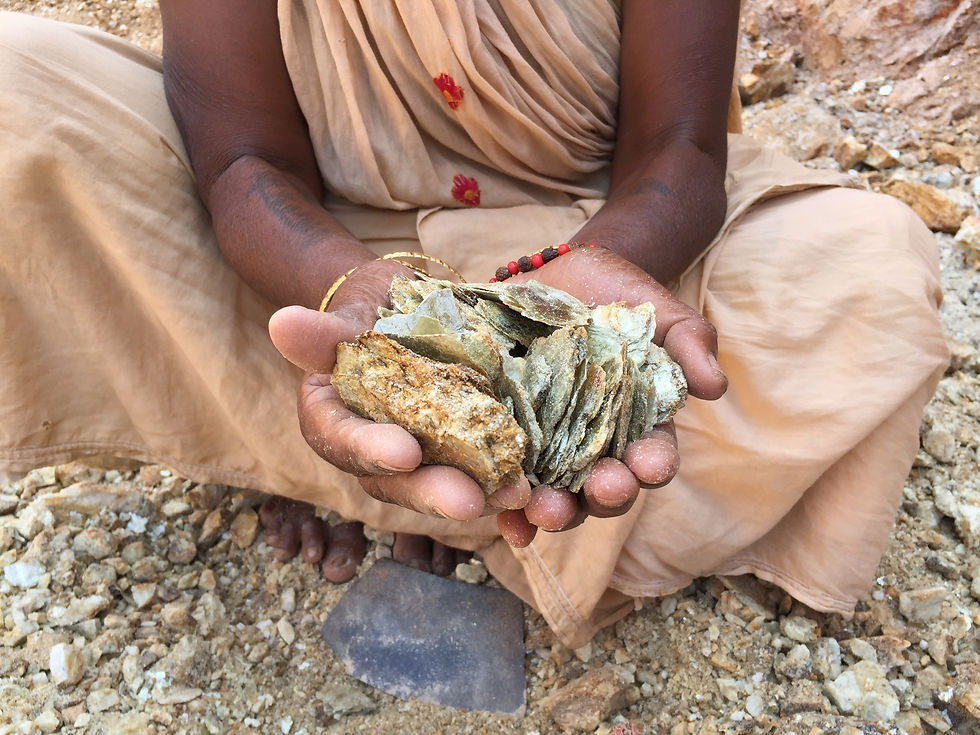Industry Deep Dive - All That Shimmers Is Not Gold: Environmental Pollution
- e0325394
- Apr 11, 2022
- 3 min read
When it comes to getting the shine in cosmetics, glitter used to be a popular option. However, following a rise in consumer awareness of the negative impacts of microplastics (which I have discussed in this post), many have turned towards an alternative —Mica.
Mica is a natural and biodegradable ingredient, surely it can’t be too harmful for the environment right?
Well, it is indeed easy to find comfort in labels of ‘organic’ and ‘natural’ ingredients. Yet, further research into the Mica mineral has proven otherwise. On the contrary, it is rather evident that throughout its supply chain, Mica has contributed significantly to environmental pollution.

Pollution from Mica production begins at its extraction process. As the mineral is embedded within coarse igneous rocks, it is obtained through either deep shaft or open pit surface mining methods. These methods utilize large amounts of explosives in order to expose pockets of Mica for miners to access. As a result, soil erosion and sinkholes are formed, polluting surrounding water resources, such as our groundwater, in the process (Monjezi et al., 2009).
A noticeable form of such environmental damage is metal pollution. During mining, heavy metals seep into our soils and water systems, which then end up being absorbed by plants. For example, Nagaraju and Karimulla (2002) conducted biospeculation of the plants found along the Nelore Mica belt in India. They found out that Mica production causes excessive amounts of heavy metals such as iron, magnesium and calcium to be present in the plants’ tissues and soils.
Although small amounts of heavy metals may not result in much effect, when in large concentrations, these metals can have detrimental impacts on plant health. This is so as the cations of these metals are solubilised and removed by leaching (whether natural or human-induced). In the process, it will leave a residue that is deprived of these easily soluble bases. Consequently, the nutrients such as the potassium ion needed by plants is significantly reduced, and normal plant functions like protein synthesis are greatly disrupted (Sustr et al., 2019).

(Source:https://education.seattlepi.com/water-pollution-affect-plants-life-cycle-4815.html)
Moving away from production processes, the consumption of these mica products have also contributed significantly to environmental damage. As we wash our Mica products into our drain systems, they are often transported to our aquatic habitats (Tagg and Ivar do Sul, 2019). Then, accumulation of this shimmer product can alter water chemistry by enhancing nitrate concentrations. This can lead to ecological impacts such as the lowering of chlorophyll b and c in duckweeds that are commonly found in freshwater systems. This has escalating consequences and may reduce vital primary producers such as microalgae and dinoflagellates in our habitats (ibid.).
A Wider Implication
So far, I have covered how Mica has impacted our environments. However, humans are not spared from the environmental pollution that Mica causes. Giri et al. (2021) notes how Mica contamination in our groundwater has posed health risks such as cardiovascular disease and non-carcinogenic health problems. While we sit in the comfort of our own homes, away from the reach of these pollution impacts, children and women that are often involved and reside in these Mica mining sites expose themselves to these health problems daily. Therefore, I believe it is in our duty to take on some form of accountability for the results of our actions. It is easy for us to neglect problems that we do not experience firsthand, but I hope this post can serve a reminder that other people might be on the wrong end of our consumption decisions!
Coming Up
Following this sentiment, what could be done to improve the situation of Mica mining? Find out in the next post why the answer to this question is never one that is straightforward and simple!
Stay tuned and stay concerned,
Hui Jie
References
Giri, S., Bharat, A. P., & Singh, A. K. (2021a). Metal contamination of groundwater in the mica mining areas of Jharkhand: assessing seasonal variation, sources and human health risk. International Journal of Environmental Analytical Chemistry, 1-14.
Giri, S., Mahato, M. K., Singh, P. K., & Singh, A. K. (2021b). Non-carcinogenic health risk assessment for fluoride and nitrate in the groundwater of the mica belt of Jharkhand, India. Human and Ecological Risk Assessment: An International Journal, 27(7), 1939-1953.
Green, D. S., Jefferson, M., Boots, B., & Stone, L. (2021). All that glitters is litter? Ecological impacts of conventional versus biodegradable glitter in a freshwater habitat. Journal of Hazardous Materials 402, 124070. https://doi.org/10.1016/j.jhazmat.2020.124070
Nagaraju, A., & Karimulla, S. (2002). Accumulation of elements in plants and soils in and around Nellore mica Belt, Andhra Pradesh, India–a biogeochemical study. Environmental Geology, 41(7), 852-860.
Tagg, A. S., & do Sul, J. A. I. (2019). Is this your glitter? An overlooked but potentially environmentally-valuable microplastic. Marine pollution bulletin, 146, 50-53.
Sustr, M., Soukup, A., & Tylova, E. (2019). Potassium in root growth and development. Plants, 8(10), 435.



Comments